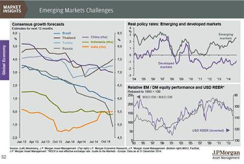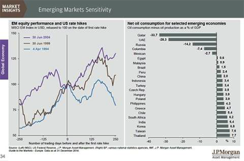Following a difficult stint of underperformance relative to their developed-markets counterparts, emerging markets are fighting an uphill battle against many challenging headwinds. Some of these headwinds are in the form of external shocks, such as commodity price weakness, potentially rising U.S. interest rates and the strength of the U.S. dollar. Others are problems of their own making, Russia being the most prominent example.
This pattern has become all too familiar to investors in the asset class in recent years. In fact, the MSCI Emerging Markets index ended 2014 very close to the lows reached in each of the three prior years, when market fears peaked. In 2013 the taper tantrum crushed so-called Fragile Five currencies. In 2012 the euro debt crisis led to widespread fears of a European Union breakup. And in 2011 the U.S. debt ceiling debate and U.S. debt downgrade shook global markets to their core. Each of these “points of maximum pessimism,” quoting the late Sir John Templeton, took markets to roughly the same levels as today. Each proved to be a buying opportunity — at least for a powerful cyclical rally. The rallies occurred not because the underlying issues were always resolved but rather because investors had overextrapolated short-term trends and overdiscounted extremely pessimistic scenarios.
Taking a closer look at current conditions, the chart below shows how periods of rising dollar strength haven’t proved to be particularly positive for emerging markets.
Chart 1 (click to enlarge)

An important caveat to keep in mind is that not all countries or sectors — or indeed even individual companies — will respond the same way. As a result, differentiation when investing is critical. For example, the bar chart below shows the differences in net oil consumption across emerging markets, illustrating the range between oil-exporting countries and those that are dependent on importing energy resources. Falling oil prices are an obvious negative for exporters but are very beneficial to countries like India that are major net importers. The wide variance in commodity price sensitivity as well as currency volatility across the asset class underscores the importance of taking an actively managed approach, rather than relying on passive exposure.
Chart 2 (click to enlarge)

The headwinds don’t fundamentally undermine the compelling long-term story of growth in emerging markets, particularly given that valuations on stocks in some of the fastest-growing parts of the world continue to look very attractive on a historical basis. It is unlikely that emerging markets will offer sustained outperformance, however, until there is clear evidence of a turn in corporate earnings. For those wary of the pitfalls in the present landscape, a more defensive approach to emerging-markets investing by, for example, picking dividend-paying stocks can help mitigate some of the downside while still capturing growth. Dividend-per-share growth of emerging-markets companies has outpaced developed markets even as emerging-markets earnings growth has disappointed on a relative basis.
Income-oriented investors can pick companies with high and rising dividends and the potential for capital growth, effectively fishing in a better-quality pond by choosing among companies that prioritize shareholder value. Taiwan offers a number of companies that are achieving some growth — a difficult thing to do at this time — primarily in the technology and semiconductor space, and that want to pay decent dividends to shareholders.
Turkey and Saudi Arabia look interesting from an income perspective, and South Africa is a good example of where to access the dividend power in individual stocks. The economic outlook might be average, but a primary attraction of South African companies is their commitment to returning capital to shareholders in the form of dividends. The key to picking a company in an emerging market in which to invest is to find a combination of cheap currency valuations and strong dividend yields. Russian materials company Norilsk Nickel is a good example. It’s the world’s largest and lowest-cost nickel producer globally with a large reserve base. It generates revenue in U.S. dollars, which helps mitigate the direct impact of the ruble’s weakness. And the company is meeting its dividend targets.
In a volatile environment, seeking out the best emerging-markets companies that pay high and rising dividends and grow their earnings can generate a sustainable source of income as well as capital growth. This combination has been powerful source of total returns over the long term. High-yielding stocks have consistently outperformed low-yielding stocks, with lower volatility.
Richard Titherington is chief investment officer and head of the emerging-markets equity team at J.P. Morgan Asset Management in London.
Get more on emerging markets.






